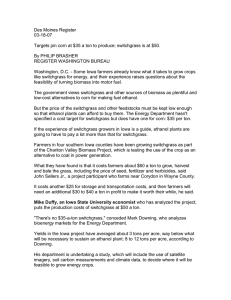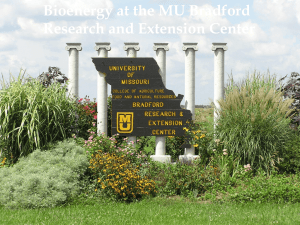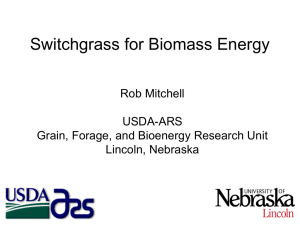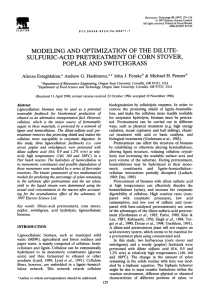Some Water Quality Impacts of Alternative Energy Crops and Catherine L. Kling
advertisement
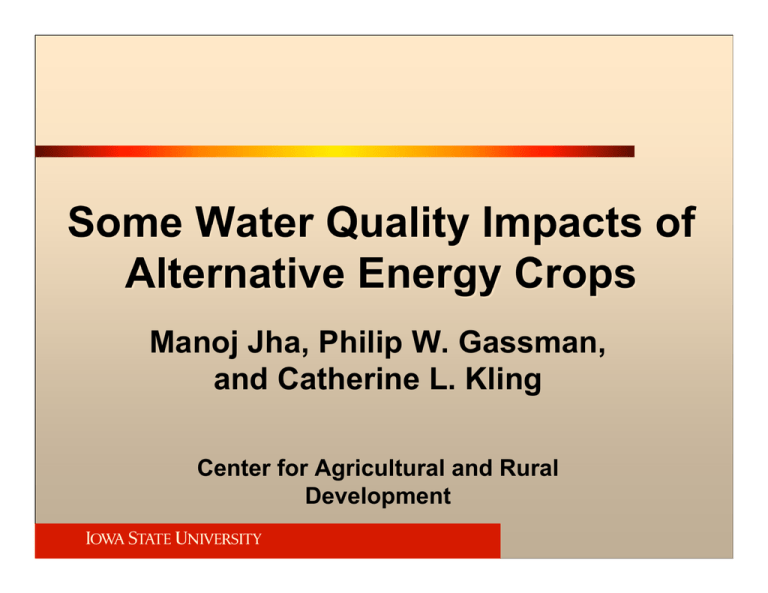
Some Water Quality Impacts of Alternative Energy Crops Manoj Jha, Philip W. Gassman, and Catherine L. Kling Center for Agricultural and Rural Development Biomass Energy Crops and the Environment • Consider two sources of biomass: – Corn stover – Switchgrass • Conventional wisdom – Reliance on stover increases environmental damage – Reliance on switchgrass will lower it Investigate effects of these crops on water quality • Three very stylized scenarios • Single watershed in Iowa • Much is unknown about how these crops would actually be grown and harvested • Thus, findings reported here should be considered suggestive and preliminary Maquoketa River Watershed Maquoketa River Watershed • Major contributor of sediments and nutrients to Mississippi River • Dominant land uses – Cropland (corn and soybeans) 55% – Grassland (pasture) 32% – Forest 10% – Urban 3% Model/Data SWAT- Soil and Water Assessment Tool – Predicts effect of land management practices on hydrology and water quality – Watershed based – Extensively used, over 250 peer reviewed publications Model/Data Key Data – U.S. Geological Survey, Iowa Geological Survey Bureau: Flow, water quality data, – National Resource Inventory: land use, cropping history, slope, etc. – Weather, soils, etc. – Model calibrated using flow, sediment, and nitrates Scenarios • Meant to illustrate extremes • Three land use scenarios – Switchgrass: convert all potential cropland to switchgrass – Corn: convert all potential crop land to continuous corn, remove 50% biomass – Mixed strategy: switchgrass on HEL, continuous corn elsewhere Scenarios • Compare each to Baseline – Baseline is current land use – Compare streamflow, sediment, nitrate, total N, and total P 1. Switchgrass • All potential cropland becomes switchgrass, includes current CRP • No tillage of soil undertaken • Spring fertilization: 110 lb/ac of nitrogen fertilizer, 60 lb/ac of phosphorous • No fall fertilization 2. Corn • All potential cropland becomes continuous corn • Remove 50% biomass • Mulch tillage operation • Fertilization rates: 182 lb/ac of nitrogen, 54 lb/ac of phosphorous 3. Corn and Switchgrass • Switchgrass on HEL, continuous corn elsewhere • Highly Erodible Land = Erosion Index 8 • Switchgrass on HEL land, 53% of watershed • Corn elsewhere, 47% of watershed Summary Findings Description Stream Flow (mm) Sediment Total Nitrate Total N Yield P (Tons) (Tons) (Tons) (Tons) Baseline 250 146,652 8,380 10,030 360 1. All Switch Grass 255 22,780 4,673 4,697 65 257 180,054 20,738 25,067 857 254 119,135 12,382 13,201 206 2. All Corn (remove 50% biomass) 3. Mixed (corn HEL<8) Summary Thoughts • Significant move towards continuous corn and biomass removal likely to worsen water quality • Switchgrass relatively water quality friendly • Targeting switch grass to highly erodible land can dampen water quality problems from continuous corn, but may still be problematic, particularly with respect to N • Much better understanding of these sytems needed

